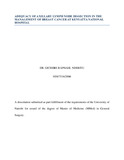| dc.contributor.author | Gichere, Raphael N | |
| dc.date.accessioned | 2014-12-03T09:18:44Z | |
| dc.date.available | 2014-12-03T09:18:44Z | |
| dc.date.issued | 2014 | |
| dc.identifier.citation | Degree of Master of Medicine (MMed) in General Surgery | en_US |
| dc.identifier.uri | http://hdl.handle.net/11295/76033 | |
| dc.description.abstract | Background: Axillary lymph node status is the most important prognostic factor in the management of breast cancer and is used to guide adjuvant treatment. When axillary lymph node dissection (ALND) is done, retrieval of at least 10 lymph nodes for histopathology analysis is considered optimal. This is to avoid stage migration. Although mastectomy plus ALND is a common operation in our setting we do not know the adequacy of the dissection.
Objective: To determine the adequacy of ALND in the management of breast cancer at Kenyatta National hospital (KNH).
Study design: Cross-sectional study done over one year.
Setting: KNH general surgical wards, and histopathology laboratory.
Patients and methods: Seventy three consenting female patients with histologically confirmed breast cancer who underwent modified radical mastectomy (MRM) were recruited into the study. Patient’s demographic data and histopathology data for the ALND specimen were recorded. Histopathology evaluation was performed by the pathologists assisted by technicians. Data on tumor histology, size and number of nodes retrieved was filled into the data sheet.
Main outcome measures: This was done by analysis of number of retrieved lymph nodes as the dependent variable and its association to the patients’ demographic data and histopathology data.
Data analysis:The number of lymph nodes retrieved was analyzed as both a continuous and a categorical variable (<10 or ≥10 nodes). Adequacy of ALND was defined as the presence of 10 or more lymph nodes (LN) in the ALND specimen.
Results:The mean number of LN retrieved was 12.12 (median 11, mode 10) and 62 (84.9%) of patients had ≥10 lymph nodes retrieved. Adequacy of ALND was not associated with patients’ demographics, tumor factors or the surgeon i.e. consultant surgeon or supervised surgical resident.
Conclusion:Axillary dissection nodal yield is a surrogate marker for the quality of the accuracy of ALND for staging and locoregional control of breast cancer. Surgeons should be aware of current guidelines on adequate axillary dissection for consistency in the extent of ALND | en_US |
| dc.language.iso | en | en_US |
| dc.publisher | University of Nairobi | en_US |
| dc.title | Adequacy of axillary lymph node dissection in the management of breast cancer at Kenyatta National Hospital | en_US |
| dc.type | Thesis | en_US |
| dc.description.department | a
Department of Psychiatry, University of Nairobi, ; bDepartment of Mental Health, School of Medicine,
Moi University, Eldoret, Kenya | |
| dc.type.material | en_US | en_US |

